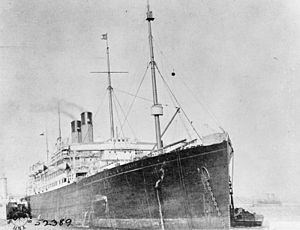RMS Celtic (1901)

RMS Celtic in 1919.
|
|
| History | |
|---|---|
|
|
|
| Name: | RMS Celtic |
| Owner: | White Star Line |
| Route: | Liverpool - New York City |
| Builder: | Harland and Wolff, Belfast |
| Yard number: | 335 |
| Launched: | 4 April 1901 |
| Completed: | 11 July 1901 |
| Maiden voyage: | 26 July 1901 |
| Fate: | Ran aground on 10 December 1928, scrapped on site |
| General characteristics | |
| Tonnage: | 20,904 GT |
| Length: | 701 ft (214 m) |
| Beam: | 75 ft (23 m) |
| Installed power: | 14,000 ihp (10,000 kW) |
| Propulsion: |
|
| Speed: | 16 kn (18 mph; 30 km/h) |
| Capacity: |
|
RMS Celtic was an ocean liner owned by the White Star Line. The first ship larger than the SS Great Eastern in gross tonnage (it was also 9 feet (2.7 m) longer), Celtic was the first of a quartet of ships over 20,000 tons, dubbed The Big Four.
Celtic was launched on 4 April 1901 from the Harland and Wolff shipyards in Belfast, and set off on her maiden voyage from Liverpool to New York City on 26 July.
She and her three sisters proved to be immensely popular with travelers, particularly immigrants. During the infamous 1904 Rate War she set the record for the highest number of passengers carried in a single crossing in White Star's history. She arrived in New York on 16 September fully booked with 2,957 passengers onboard.
At the beginning of the First World War, Celtic was converted into an armed merchant cruiser; however since the vessel had a high fuel consumption it was decided to convert her into a troop ship in January 1916 when she was used to carry soldiers to Egypt. She was put back on the transatlantic route in March 1916.
In 1917, Celtic struck a mine off the Isle of Man. Seventeen people on board were killed, but the Celtic survived. A number of passengers were rescued by the London and North Western Railway ship Slieve Bawn. Celtic was towed to Peel Bay and repaired in Belfast. In March 1918, U-Boat UB-77 torpedoed Celtic in the Irish Sea. Six people on board were killed, but again Celtic remained afloat. Eventually the damaged vessel was towed to Liverpool and repaired again.
...
Wikipedia
